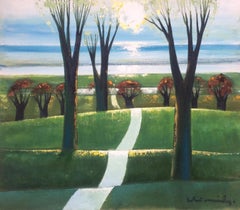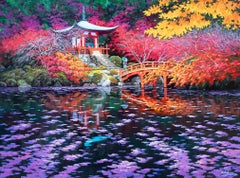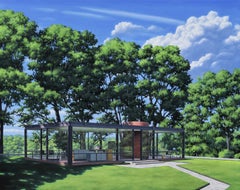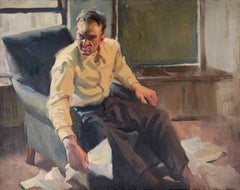Park Interior Paintings
to
2
3
Overall Width
to
Overall Height
to
1
2
1
1
1
3
392
2,348
1,531
1,188
714
666
628
625
588
563
554
357
248
224
197
185
171
171
170
168
3
3
1
1
1
1
1
2
1
Art Subject: Park
The road to the sun 1996, cardboard, oil, 74x85 cm
Located in Riga, LV
The road to the sun
1996, cardboard, oil, 74x85 cm
The composition depicts a landscape where a road leads towards the sun, with the sea visible in the background.
The focal point ...
Category
1990s Modern Landscape Paintings
Materials
Oil, Cardboard
$7,652 Sale Price
20% Off
Falling Leaves. Old Kyoto, Japan., Oil Painting
Located in San Francisco, CA
Artist Comments
A lone figure in a kimono crosses a picturesque bridge within the Daigoji Temple grounds in Kyoto, Japan. Autumn leaves float gently on the tranquil pond, sho...
Category
21st Century and Contemporary Impressionist Interior Paintings
Materials
Oil
Afternoon At The Glass House
By Danny Heller
Located in Fairfield, CT
My latest series opening at the George Billis Gallery, titled “Modern Society,” continues my exploration into midcentury architecture and design found in New York City, but focuses o...
Category
21st Century and Contemporary American Realist Interior Paintings
Materials
Canvas, Oil
$7,104 Sale Price
20% Off
Related Items
Sunset Over The Fireweed Field - sunset landscape painting
Located in Zofingen, AG
Summer evening landscape is a beautiful interior decoration. Summer sunsets always admired the artist. Nikolay was looking for the ways to capture the evening glow on the canvas many...
Category
2010s Impressionist Landscape Paintings
Materials
Canvas, Oil
$1,435 Sale Price
25% Off
H 31.5 in W 23.63 in D 0.79 in
Portrait of a Man in Armchair, Mid Century Short Story Illustration
Located in Soquel, CA
Excellent figurative oil painting of a man seated in an armchair with papers strewn about the interior space by Charles Ross Kinghan (American, 18...
Category
1930s American Impressionist Figurative Paintings
Materials
Linen, Oil
$2,120 Sale Price
20% Off
H 24 in W 30 in D 0.75 in
Mid Century Pink & White Roses in Crystal Vase Still-Life
Located in Soquel, CA
Delicate mid century still-life of white and pink roses in crystal vase with a soft, lime green background by listed California artist Helen Mae Enoch Gleiforst (American, 1903-1997)...
Category
1950s American Impressionist Still-life Paintings
Materials
Canvas, Oil
$1,267 Sale Price
35% Off
H 24 in W 20 in D 1 in
Mid Century Chianti with Orange Still Life
By Claude Buck
Located in Soquel, CA
Still life "Wine with Orange" by Claude (Charles Claude) Buck (1890-1974). Signed lower left. Artist's notes and color scheme on verso. Displayed in rustic giltwood frame. Image, 14"...
Category
1940s American Impressionist Still-life Paintings
Materials
Oil, Masonite
$2,275 Sale Price
35% Off
H 15 in W 17 in D 3 in
"Old Shoemaker" Ashcan 20th Century Modernism 1924 California WPA Realism Worker
By Otis Oldfield
Located in New York, NY
"Old Shoemaker" Ashcan 20th Century Modernism 1924 California WPA Realism Worker. Signed “Otis Oldfield” lower left. 14 x 12 inches.
Exhibited: Galerie des Beaux Arts, San Francisco, CA, 1925
Provenance: Estate of the Artist
Born in Sacramento, CA on July 3, 1890, Otis Oldfield left high school at age 16 to work in a local print shop. In 1909 he arrived in San Francisco and enrolled at the Best Art School. After working for two years as a bellhop at the Argonaut Hotel and as a hat check boy at the Cliff House, he had saved enough money for further studies in Paris. In 1911 he sailed for France and enrolled at Académie Julian. Caught up in the activities of wartime Paris, he was an apprentice for a book...
Category
1920s American Realist Figurative Paintings
Materials
Canvas, Oil
God Bless Our Home, Social Realist Scene, Figurative Americana Interior Scene
Located in Doylestown, PA
"God Bless Our Home" is an interior and figurative scene of a woman sitting on her couch in serious and proper expression. The Americana style paint...
Category
1930s American Realist Figurative Paintings
Materials
Canvas, Oil
$2,300 Sale Price
50% Off
H 24 in W 28 in D 2 in
Fragment of a sea wave
Located in Zofingen, AG
In creating this painting, I sought to capture the essence and vitality of the sea. With each brushstroke, I instilled the raw power and restless spirit of ocean waves. This piece, c...
Category
2010s Expressionist Landscape Paintings
Materials
Canvas, Oil, Cardboard
Sea. Sailboat.
Located in Zofingen, AG
In this piece, I sought to capture the serene dance between sky and sea, interspersed with the graceful ballet of a sailboat. Infused with the essence of expressionism and the delica...
Category
2010s Expressionist Landscape Paintings
Materials
Canvas, Oil, Cardboard, Giclée
Yachts
Located in Zofingen, AG
In creating this piece, I aimed to capture the tranquil beauty of yachts at sunset, the hues reflecting the day's end. My strokes blend expressionism with impressionism's charm, evok...
Category
2010s Expressionist Landscape Paintings
Materials
Canvas, Oil, Cardboard, Giclée
White Horse Carousel, 1956 - Original Oil Painting On Linen
Located in Soquel, CA
White Horse Carousel, 1956 - Oil On Canvas
Oil painting of an empty carousel ride, a single white horse gleams in the center. Three doorways are seen to the right, with sunlight ema...
Category
1950s American Impressionist Figurative Paintings
Materials
Oil, Linen
$650
H 18.25 in W 25.25 in D 0.5 in
Along the golden alley
Located in Zofingen, AG
In this piece, I aimed to capture the serene beauty of autumn, where the whisper of falling leaves and the soft, golden light create a peaceful retreat from the world. The lone figur...
Category
2010s Expressionist Landscape Paintings
Materials
Canvas, Oil, Cardboard, Giclée
Dandelions
Located in Zofingen, AG
In this artwork, I've aimed to capture the transient beauty of nature, an expression of life's fleeting moments. Employing gentle strokes and a harmonious palette, I convey the delic...
Category
2010s Expressionist Landscape Paintings
Materials
Oil, Giclée, Cardboard, Canvas
Recently Viewed
View AllMore Ways To Browse
19th Century Oil Painting Forest Deer
A Colomer
African Wild Dog
Aldro Hibbard Thompson
Alice In Wonderland Doors
Amen Irving
Ana Guzman
Andre Barbier
Anne Redpath
Antique Pilgrims Progress
Antonio Jacobsen Oil Paintings
Art Africain
Art Sea Cliff Ny
Arthur Stewart
Augustus Francis
Baie Des Anges
Baron Watch
Bern Hill



